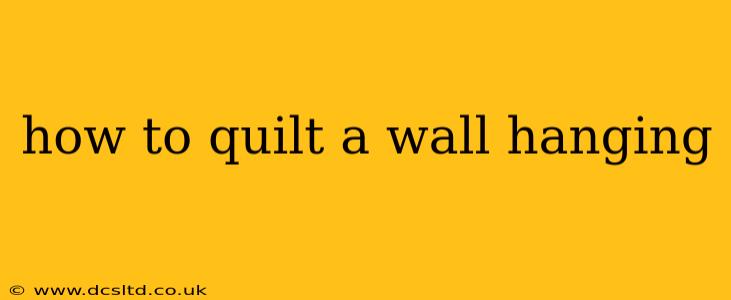Creating a quilted wall hanging is a rewarding experience, blending creativity and craftsmanship. Whether you're a seasoned quilter or a complete beginner, this guide will walk you through the process, from choosing your design to hanging your finished masterpiece. We'll cover various techniques and answer common questions, ensuring you create a unique and beautiful piece of textile art.
What materials do I need to quilt a wall hanging?
The materials required depend on your chosen design and size, but here’s a comprehensive list to get you started:
- Fabric: Choose fabrics that complement each other in color and texture. Cotton is a popular choice for its ease of use and wide range of patterns available. Consider using quilting cotton for its durability. For a more unique look, experiment with linen, silk, or even repurposed fabrics.
- Batting: This provides the insulation and softness to your quilt. Cotton batting is a classic and readily available option. Other options include wool batting (for a luxurious feel) or polyester batting (for a more budget-friendly choice).
- Backing Fabric: This fabric will be the back of your wall hanging. Select a sturdy fabric that will hold up well over time. Again, quilting cotton is a reliable choice.
- Thread: Choose a thread that matches your fabric or creates a pleasing contrast. High-quality quilting thread is recommended for its strength and durability.
- Quilting Needles: Use needles appropriate for your chosen fabric and thread. A size 14 or 16 needle is a good starting point for most quilting projects.
- Rotary Cutter & Mat (Optional but Highly Recommended): These tools make cutting fabric much more efficient and accurate.
- Scissors: Sharp fabric scissors are essential for precise cutting.
- Ruler: Use a clear ruler for accurate measurements.
- Pins: Use quilting pins to hold your fabric layers together.
- Sewing Machine (Optional but Recommended): While hand-quilting is possible, a sewing machine significantly speeds up the process, especially for larger projects.
- Iron & Ironing Board: Pressing your fabric as you go will keep your quilt looking neat and professional.
What are the different types of wall hanging quilts?
Wall hangings offer boundless creative freedom. Here are some popular types:
- Appliqué Quilts: These feature fabric pieces sewn onto a background fabric, creating intricate designs and pictures.
- Patchwork Quilts: These use various fabric squares or shapes sewn together to create a larger design. They can be simple or extremely complex.
- Modern Quilts: These often incorporate bold colors, geometric patterns, and minimalist designs.
- Traditional Quilts: These quilts follow established patterns and techniques, often showcasing intricate stitching and designs passed down through generations.
How do I choose a pattern for my wall hanging?
Choosing a pattern depends on your skill level and desired aesthetic. Beginners might find simple patchwork or single-block designs easier to manage. More experienced quilters can tackle intricate appliqué or complex geometric patterns. Plenty of free and paid patterns are available online and in quilting books. Consider these factors when choosing a pattern:
- Skill level: Start with a simple design if you're a beginner.
- Size: Determine the desired size of your wall hanging.
- Fabric: Select a pattern that complements your chosen fabrics.
- Theme: Choose a theme that reflects your personal style.
What is the best way to quilt a wall hanging?
The quilting process involves three layers: the top fabric (your chosen design), the batting, and the backing fabric. These layers are pinned together, and then quilted using various techniques:
- Machine Quilting: This is the fastest and most efficient method. Use walking foot attachment on your machine for even feeding of all three layers.
- Hand Quilting: This offers a more personalized touch and can create unique textures. A quilting frame can be helpful for larger projects.
- Free-motion Quilting: This technique allows for more creative designs and is commonly done with a sewing machine.
How do I finish the edges of my quilted wall hanging?
Finishing the edges of your quilt is crucial for a professional look and to prevent fraying. Common finishing methods include:
- Binding: This involves sewing a strip of fabric around the edges of the quilt.
- Serging: This uses a serger machine to create a neat, finished edge.
- Zigzag Stitch: Use your sewing machine's zigzag stitch to prevent fraying.
How do I hang my finished quilted wall hanging?
Once your wall hanging is complete, you can hang it in several ways:
- Rod Pocket: Sew a rod pocket at the top of your quilt.
- Hanging Sleeve: Sew a sleeve at the top for hanging a rod or dowel.
- Hanging Loops: Sew small loops to hang with hooks.
Creating a quilted wall hanging is a journey of creativity and skill-building. Start with a simple project, and as you gain experience, explore more intricate designs and techniques. The process is as enjoyable as the final product, providing a unique piece of art that reflects your personal style and artistry. Remember to enjoy the process and don't be afraid to experiment!
